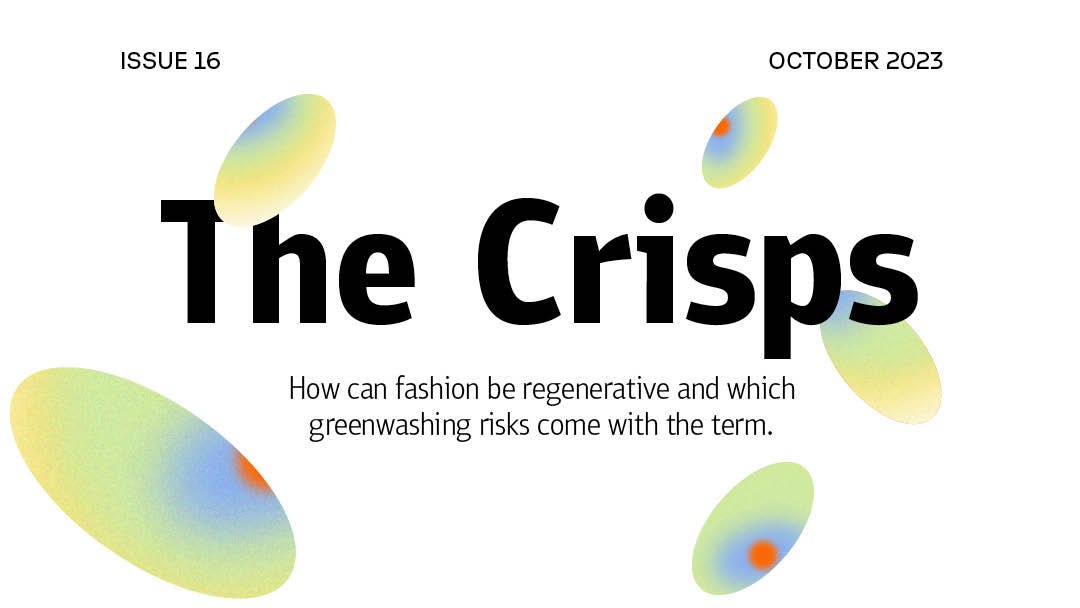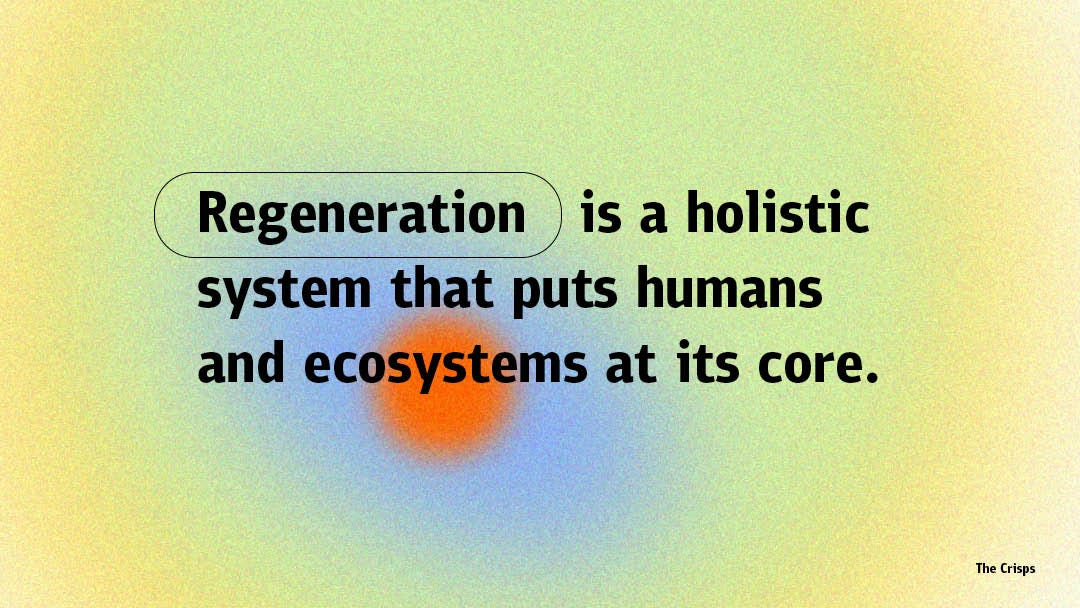Regenerative: Fashion's new favorite buzzword
But what does it really mean? How can fashion be regenerative and which greenwashing risks come with the term?
Welcome to The Crisps–your weekly newsletter on anti-greenwashing and honest fashion communication. In this issue, we look at one of the industry’s new favorite buzzwords: regenerative fashion/cotton/design/(swap in any noun you like). If you haven’t subscribed yet, make sure to not miss out on our deep dive next week – and any other issue for that matter. Glad you’re here!
Regenerative fashion, regenerative cotton, regenerative everything. The buzzword of the hour has long outranked “sustainable” – also in the fashion sector. Who really wants to bring across their commitment to people and the planet nowadays uses the term “regenerative”, right?
It sounds novel, progressive, and like we’re revolutionizing the industry from the ground up – so we get the hype. But what does it really mean? Is there any substance behind the term or just shallow promises?
In this issue, we try to find answers (which is not so easy as there is no protected term or definition). So instead of solely telling you HOW and WHAT to do, we want to open a discussion on regenerative fashion. If you’ve read this issue, hop on over to the channel of your choice (Instagram or LinkedIn), and let’s get talking.
What does the term regenerative mean?
Before we dive into the fashion sector, let’s have a look at regenerative agriculture – because like so many other topics it’s directly linked to fashion. And the concept has been talked about in agriculture a lot in recent years. Why? Because there are close ties between agriculture, food sovereignty & production, and ecological health.
If you find yourself unsure of a short definition that really explains what regenerative agriculture could mean, you’re not alone. Because there’s not one agreed-upon definition of what practices are behind regenerative agriculture. Instead, it is viewed as a holistic system that puts humans and ecosystems at its core.
In this system, farming methods like no-till1 might be used to restore soil health, improve water cycles, and increase biodiversity as well as soil carbon levels and socioeconomic outcomes. Additionally, regenerative agricultural practices are supposed to increase yields and resilience against climate extremes.
But this isn’t a new system – even though the term popping up everywhere might suggest otherwise. For Indigenous people, regenerative agriculture is a given.2 So when we speak about this seemingly “new” solution, it’s important to keep the roots in mind. And acknowledge that many communities, especially indigenous and marginalized groups, have suffered due to exploitative practices. That’s why part of the discussion around regeneration should be about reparative measures and diverse knowledge systems including Indigenous ecophilosophies – not only restoring the land but also compensating and supporting communities that have historically been exploited or displaced.
Important addition: While most talk about regeneration as a system, it’s not always tied to rethinking our economic and socio-cultural models. But we believe this aspect is just as important. Because our current growth-driven model often leads to overconsumption, depletion of resources, and a rise in injustice. If regeneration is supposed to achieve the effects it is hailed to have, we need a shift towards relational values, sustainable, equitable growth, or even degrowth of overdeveloped sectors.
Regenerative Fashion: Embracing complexities
The fashion industry, like many others, is not exempt from the misuse of terms such as "regenerative" as part of their branding and marketing strategies. As consumers become more conscious of the environmental and social impacts of their purchases, brands in the fashion industry are keen to position themselves as sustainable – or better yet regenerative. But as there is not one agreed-upon definition, we try to get the idea behind it down to the most important aspects.
Prioritizing restoration, regenerative fashion focuses on nurturing soil health, preserving biodiversity, and bolstering carbon sequestration, particularly when sourcing materials like cotton, wool, or other natural fibers.
Regenerative fashion encompasses practices within the fashion sector that aim not only to mend the environmental scars, such as damage to ecosystems and biodiversity loss but also to address historical and ongoing social injustices related to clothing and accessory production.
By integrating principles of decolonization and social justice, it acknowledges and rectifies the often-overlooked appropriation and exploitation of indigenous and marginalized communities' knowledge and resources.
Moreover, in line with degrowth philosophies, it challenges the industry's unsustainable expansion and consumption patterns, seeking a balance that benefits both the planet and its many and diverse inhabitants.
Lastly, genuine regenerative fashion also considers reparations, aiming to provide tangible remedies for communities historically harmed or marginalized by the fashion industry's practices.
We are curious to see what you think and how you understand regenerative fashion! What does it entail? Scribble down your thoughts and:
"Regenerative" and Greenwashing risks
While we highly welcome the concept of regenerative agriculture and fashion, there is a high risk of greenwashing. Here’s a list of aspects to be aware of:
🔹 Selective Storytelling: There's a rise in brands narrating heartwarming stories of farming practices or community collaborations. However, they conveniently leave out portions of their supply chain that remain destructive or exploitative. It doesn’t mean you should not tell those stories! But make sure, you are honest about your challenges.
→ This could be as simple as sharing with your audience, that you’re still working on disclosing all of your Tier 4 suppliers.
🔹 Exploitative Usage: Many companies, in their effort to seem environmentally friendly, attach buzzwords like "regenerative" to their products and practices without substantially backing up their claims.
→ Remember only to communicate things you actually DO, like really put into place!
🔹 Lack of Certification: Neither are there any universally agreed-upon standards for what constitutes "regenerative" practices nor are there standardized certifications for regenerative fashion. Without clear benchmarks, it's easy for companies to define the term in ways that suit them. That is highly risky and can lead to greenwashing faster than you think. Plus, regenerative certifications in fashion are viewed with skepticism due to prevalent greenwashing and often ambiguous standards. We will get into more detail on this topic in our pro issue next week.
🔹 Short-Term Focus: True regenerative practices are about long-term ecosystem health and resilience. Misuse often arises when there's a focus on short-term yields or benefits without regard for long-term socio-ecological impact.
🔹 Narrow Focus: Brands may focus only on soil health or carbon capture as regenerative while neglecting broader ecosystem health, water conservation, and community well-being. True regeneration should follow a holistic approach.
🔹 Surface-Level Changes: Some companies might adopt minor or superficial regenerative practices but promote them disproportionately, thereby overshadowing their other non-sustainable activities.
🔹 Overlooking Social Aspects: Truly regenerative practices also consider the socio-economic benefits for local communities. Misuse can occur when there's a focus solely on environmental aspects, neglecting the social dimensions.
🔹 Loss of Original Meaning: Overuse and misuse of “regenerative” can dilute the term's original meaning, making it less strong as a description for genuinely transformative and sustainable practices.
🔹 Oversimplification: As always, breaking down information into smaller content pieces, infographics or snackable information is risking oversimplifying a complex matter. That’s exactly the case for regenerative practices as well as “sustainable” fashion as a whole.
→ If you talk about the topic, make sure you’re addressing this risk so that you’re not painting an unrealistically rosy picture.
🔹 Overemphasis on Consumer Responsibility: Some brands put the burden of regeneration on consumers. With "buy this to save the Earth" narratives brands might divert the attention away from corporate responsibilities and needed systemic changes.
Next week, in our pro issue we will share some dos and don'ts of communicating regeneration and will get into regenerative cotton. Don’t miss this issue by becoming a paid subscriber.
All the best,
Tanita & Lavinia
🔹 Learned something in this issue? Share The Crisps with your friends and colleagues.
🔹 Like our content? Support our work with a paid subscription.
🔹 Got feedback or topics we should cover? Send us a mail to thecrisps@substack.com
Disclaimer: The content and opinions presented in The Crisps newsletter are for informational purposes only and do not constitute legal, ethical, or professional advice. The Crisps does not endorse any specific brands or products mentioned in its content.
No-till farming (also known as zero tillage or direct drilling) is an agricultural technique for growing crops or pasture without disturbing the soil through tillage. It is the agricultural preparation of soil by mechanical agitation, typically removing weeds established in the previous season.
Sands, B., Machado, M. R., White, A., Zent, E., & Gould, R. (2023). Moving towards an anti-colonial definition for regenerative agriculture. Agriculture and Human Values, 1-20.




